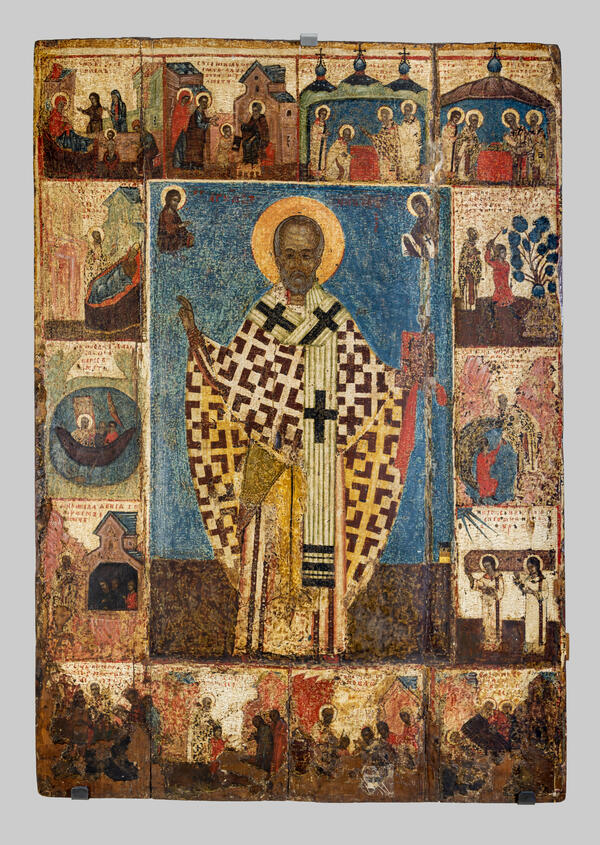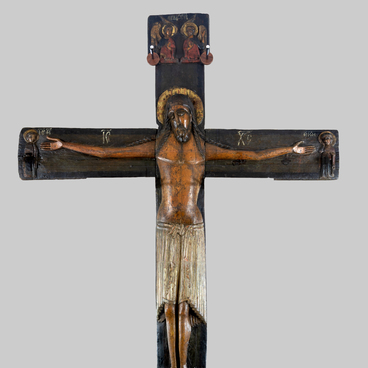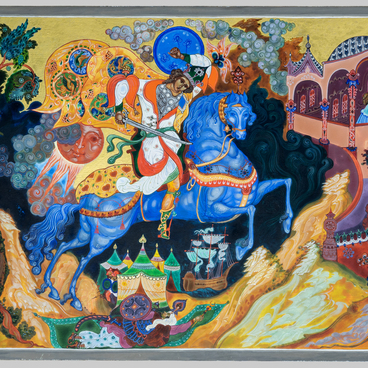St. Nicholas the Wonderworker and Scenes from His Life is the oldest icon in the collection of the State Museum of Palekh Art. It was created in the late 14th century. Its style resembles the works of RostOv-SUzdal icon painters, which suggests that it was created in the north of the YaroslAvl region.
The centerpiece depicts Nicholas the Wonderworker, Archbishop of Myra in Lycia. This saint is extremely revered by Russian Christians. Nicholas was a member of the First EcumEnical Council in 325 A.D., where the priests adopted the most important church rules. Among other things, they set a single universal date for Easter.
The centerpiece is a full-length painting if the saint in the ceremonial outfit of a bishop: a phelonion decorated with a pattern of multiple crosses and a white omophorion. The phelOnion is a sleeveless outer garment used by priests for worship services. The omophOrion is a wide ribbon with images of crosses; it is considered a symbol of the episcopal office. The saint is depicted with his arms out to the sides. He is blessing the believers with one hand and holding a closed gospel book with a vermilion edge on a vermilion piece of fabric in the other. Vermilion is a particularly bright red pigment derived from a mercury-yielding mineral. This image of St. Nicholas resembles one the most ancient icons of this saint, the icon of St. Nicholas of Zaraisk.
The icons of St. Nicholas the Wonderworker always feature the images of Jesus and the Virgin Mary. They remind of the Nicene miracle: there is a legend that, during the Council of Nicaea, Nicholas slapped his opponent, the heretic Arius, across the face. For this, the Council Fathers deprived him of his omophorion: that is, took away his title of a bishop. They then placed the saint in a prison tower. Immediately after that, many of the priests started having visions in which Jesus Christ gave the gospel to Nicholas, and the Virgin Mary put the omophorion back on him. The clerics realized they had made a mistake. They freed the saint, restored his rank, and honored him as the great God-pleaser.
The border scenes depict episodes from the life of the saint. Along with the traditional subjects like the birth of St. Nicholas, the start of his religious education, and his ordination to priesthood, the icon features rare compositions found in older monuments: for example, the miracle of the expulsion of a demon from a tree, which is combined into a single scene with the miracle of the expulsion of a demon from a source. The scenes also tell about his appearance before Constantine the Great and the deliverance of three men from execution.
The following scenes, which are located in the central part of the icon, depict the return of Vasily, Agrik’s son, from the Saracen captivity. It should be noted that such detailed compositions are more characteristic of the Novgorod icon painting tradition. The scene in the lower right corner depicts the death of Nicholas the Wonderworker. The scene above it shows the transfer of his relics to Bari. The icon features only two marine episodes: the deliverance of a ship “from the flood” during a trip to Palestine and “the raising of Dmitry from the bottom of the sea”.
Like many other masterpieces of Old Russian art in the museum’s collection, the icon was delivered to the museum from a church near Palekh that closed in the 1940s.
The centerpiece depicts Nicholas the Wonderworker, Archbishop of Myra in Lycia. This saint is extremely revered by Russian Christians. Nicholas was a member of the First EcumEnical Council in 325 A.D., where the priests adopted the most important church rules. Among other things, they set a single universal date for Easter.
The centerpiece is a full-length painting if the saint in the ceremonial outfit of a bishop: a phelonion decorated with a pattern of multiple crosses and a white omophorion. The phelOnion is a sleeveless outer garment used by priests for worship services. The omophOrion is a wide ribbon with images of crosses; it is considered a symbol of the episcopal office. The saint is depicted with his arms out to the sides. He is blessing the believers with one hand and holding a closed gospel book with a vermilion edge on a vermilion piece of fabric in the other. Vermilion is a particularly bright red pigment derived from a mercury-yielding mineral. This image of St. Nicholas resembles one the most ancient icons of this saint, the icon of St. Nicholas of Zaraisk.
The icons of St. Nicholas the Wonderworker always feature the images of Jesus and the Virgin Mary. They remind of the Nicene miracle: there is a legend that, during the Council of Nicaea, Nicholas slapped his opponent, the heretic Arius, across the face. For this, the Council Fathers deprived him of his omophorion: that is, took away his title of a bishop. They then placed the saint in a prison tower. Immediately after that, many of the priests started having visions in which Jesus Christ gave the gospel to Nicholas, and the Virgin Mary put the omophorion back on him. The clerics realized they had made a mistake. They freed the saint, restored his rank, and honored him as the great God-pleaser.
The border scenes depict episodes from the life of the saint. Along with the traditional subjects like the birth of St. Nicholas, the start of his religious education, and his ordination to priesthood, the icon features rare compositions found in older monuments: for example, the miracle of the expulsion of a demon from a tree, which is combined into a single scene with the miracle of the expulsion of a demon from a source. The scenes also tell about his appearance before Constantine the Great and the deliverance of three men from execution.
The following scenes, which are located in the central part of the icon, depict the return of Vasily, Agrik’s son, from the Saracen captivity. It should be noted that such detailed compositions are more characteristic of the Novgorod icon painting tradition. The scene in the lower right corner depicts the death of Nicholas the Wonderworker. The scene above it shows the transfer of his relics to Bari. The icon features only two marine episodes: the deliverance of a ship “from the flood” during a trip to Palestine and “the raising of Dmitry from the bottom of the sea”.
Like many other masterpieces of Old Russian art in the museum’s collection, the icon was delivered to the museum from a church near Palekh that closed in the 1940s.



